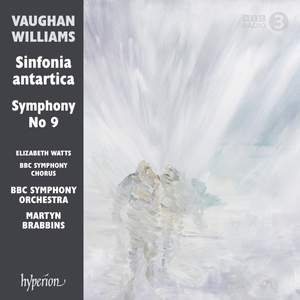
Ralph Vaughan Williams (1872-1958)
Sinfonia Antartica Symphony No. 7 (1947-52)
Symphony No. 9 in E minor (1956-57)
BBC Symphony Chorus
Elizabeth Watts (soprano)
BBC Symphony Orchestra/Martyn Brabbins
rec. 2022, Watford Colosseum, Watford, UK
Hyperion CDA68405 [79]
There is a peculiarity in this new recording of two of Vaughan Williams’ later symphonies, in that the recorded sound and orchestral playing are both so warm, rich and deep that they rather militate against suggesting the stark, glittering enmity of the icy wastes depicted in the Sinfonia antartica, that most pictorial of “programme music” – after all, it was derived from a film score – and even risk mitigating the pessimism of the Ninth. Having said that, they are undeniably beautifully played and that virtuosity is signalled by the overwhelming first climax in the Prelude of the Seventh. Comparison with Vernon Handley’s or Boult’s recordings certainly reveals them both to have a chillier sound and a more detached style of playing; neither enjoys the vividness of this Hyperion release, even after Pristine’s remastering of Boult’s into Ambient Stereo (review; review).
A certain YouTube/Classics Today critic goes out of his way to lambast this recording as a completely unatmospheric dud but I honestly do not know how he comes to that conclusion. He excoriates the tempi but they are little different from Handley’s or Boult’s – just slightly faster in the Landscape movement – and there is no difference in pulse or momentum. He also claims that there is no dynamic variation or tension, which is patently untrue; just listen to how the music builds to the first climax two and a half minutes into the first movement.
Elizabeth Watts and the BBC Symphony Chorus are more striking and present than their equivalents in either Handley’s or Boult’s recording, probably again as a function of the superior sound. I was faintly perturbed when, before I listened, I read that “The wind machine called for in the score is here presented by audio samples of actual wind”, thinking that might constitute a form of cheating or artificiality but actually it is very effectively and seamlessly integrated into the sound picture; I love it.
The Scherzo is perhaps the least successful movement in Brabbins’ account; it is insufficiently, rumbustious and quirky at the start compared with Boult’s rendition, but the “Penguin music” is more energised and the coda comes across as suitably spooky – although the glockenspiel and xylophone could be more prominent.
The Lento third movement is the heart of the symphony and must convey the pitiless indifference of Nature to man’s puny endeavours. Brabbins engineers some nicely contrasting sonorities and the tam-tam crash, three minutes in, is imposing. The extra bass in the sound adds mystery and menace to the heavy tread of the last three minutes, such that the implacable remoteness and nobility of the landscape is dramatically conveyed and the entry of the organ over the sawing orchestral accompaniment is a spine-tingling moment. In the Intermezzo, the central passage for harp, cor anglais and solo violin is ironically consolatory, like a hallucinatory vision of the temperate pastures of the England that the ill-fated explorers have left behind and will never see again. Brabbins catches its bitter-sweet mood neatly.
That mood seems to carry over into the tragic opening of the Epilogue; it is both noble and doom-laden and the stupendous digital sound assists its impact. This is macabre, disconcerting music and Brabbins’ direction encompasses its terror and its desperation. Kudos to the timpani in particular, here. The final moments are devastating and the wind effect especially eerie.
That tragic mood continues in the Ninth where there is little consolation despite the constant striving for comfort. Brabbins drives this music hard; he clearly sees this as a musical quest for some slim shard of sunlight to penetrate the prevailing dark, brooding storm clouds. Again, the sumptuousness of the recorded sound could militate against the bleakness of the music but Brabbins’ careful gradation of dynamics keeps us in constant anticipation of the next climactic crisis. I remarked in my previous review of Boult’s account of this symphony on the kinship between the Satanic music of Job and the burden of the Ninth and Brabbins does a fine job in underlining that omnipresent threat of overweening evil, yet he also permits the brief lyrical passages to bloom, such as at the end of the Andante sostenuto, before letting rip in the ghoulish Scherzo, treating it almost humorously like a grotesque parody of Dukas’ Sorcerer’s Apprentice. The finale is graced by some lovely playing by the BBC SO which enhances the sense of some hard-won reprieve and resolution having been achieved against the odds. The brave fanfare and diminuendo which conclude the movement are magnificently executed; this is as convincing an account of this “difficult” symphony as I know.
Ralph Moore
Help us financially by purchasing from


Previous review: John Quinn (March 2023)


















